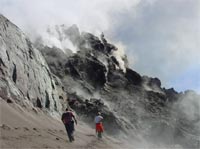Going with the Flow
When seconds can mean the difference between life and death, volcanologists spend their time adding to ours.
- By Marc Barrera
- Sep 01, 2008
 What would possess a person to go toward a volcano that may erupt? A death wish? Or could it instead be a wish to preserve life?
What would possess a person to go toward a volcano that may erupt? A death wish? Or could it instead be a wish to preserve life?
Even in the age of non-stop communications, Mother Nature still surprises us. It is the ever-present possibility of disaster that pushes volcanologists to put themselves in harm’s way. “Our intent or goal is, we want to both understand the processes that lead to volcanic eruptions, and then we also want to be able to warn people who are affected,” said John Power, Ph.D., a seismologist with the U.S. Geological Survey, Alaska Volcano Observatory.
The science of volcanology is hard to nail down. There is no formal area of study to speak of; rather, it is a hodgepodge of many separate disciplines, including geology, geochemistry, geophysics, computer science, and electrical engineering. “There’s no place where you can go to college and study volcanology,” Power said. “It’s kind of an amalgamation of those different things.”
Many Unpredictable Hazards
Certainly a volcano’s eruption threatens the safety of the nearby populace, but the team of volcanologists on scene encounters even greater risks. The dangers a volcano presents are numerous, including noxious gases such as carbon and sulfur dioxide; landslides and lahars—hot or cold mixtures of water and rock fragments that flow down the slopes of a volcano and river valleys; lava flows; pyroclastic flows—mixtures of hot, dry rock fragments and hot gases that can erupt from a vent at high speeds; and Tephra—volcanic rock and glass fragments ranging in size from ash to 1 millimeter in diameter.
The lahars and pyroclastic flows have been perhaps the most deadly of these hazards because of their unpredictability. On June 3, 1991,Maurice and Katia Krafft, a famous French husband-andwife volcanology team, were in Japan filming Mount Unzen when a pyroclastic flow killed them along with former U.S. Geological Survey geologist Harry Glicken.
Power said much of the danger is avoidable, despite the unpredictability of the work. “Those are very deadly, and we try to keep our people away from that kind of activity. Generally, the closer you are, the more likely that’s going to be a problem. That’s something that we generally would consider a proximal hazard,” he said. “We always sort of compromise.We’d like to have these instruments closer in, but it’s just too dangerous to get there.We’re not going to put our people at risk for this.”
Although seemingly less hazardous, volcanic ash from Tephra poses problems that are not as apparent on the surface. Long and severe exposure to such ash particles without protective breathing equipment can be dangerous and harmful, especially for people with heart and lung ailments. Also, because wet ash conducts electricity, it can cause short-circuits and failure of electronic components, which can affect, among other things, the safety of helicopter transport.
Because the only effective way to survive the hazards of a volcano is caution and avoidance, the PPE worn by volcanologists is largely tailored to protect against the hazards of the environment around a volcano. Power said typical clothing includes leather boots, heat-resistant clothing such as a Nomex suit, standard eye protection, and any kind of strap-on head protection, such as the type worn for mountain climbing. “Also, you want to make sure you’re able to deal with snow and freezing rain, the kind of conditions that develop hyperthermia. Those kinds of hazards I think are in some ways as real as the volcanic hazards. So I always encourage people to be ready to deal with extreme weather as well as volcanic problems,” said Power, adding that the people on his teams are required to go through wilderness survival training and first aid.
Mountain of Data
But responding to an eruption is only a small part of what volcanologists do. Their true value lies in their preventive research. Since starting in the field 25 years ago, Power has seen technology significantly raise the safety of volcanologists’work by allowing volcanoes to be remotely monitored around the country.
“When I got started, the Internet did not exist. There have been tremendous changes in technology and instrumentation, in the way the data is handled and processed, and in the way that volcanoes are observed and studied,” he said. “All that remote telemetry data is much easier to use than it was in the early days. There was a lot more data that had to be collected in the field, whereas now we put instruments out on the mountains and the data ends up back on a server somewhere that’s accessible via the World Wide Web.”
The data they collect on a volcano are put into a “Hazard Assessment” report. This report contains information that allows local authorities to properly zone and plan surrounding communities.
“It basically says these are the areas around this particular volcano that are likely to experience problems or have experienced problems in past eruptions, and, consequently, these are the high-risk areas,” Power said. From this information, zoning committees can decide where it’s best to build infrastructure versus agriculture.
This article originally appeared in the September 2008 issue of Occupational Health & Safety.